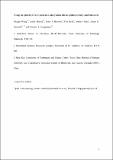Using the pimeloyl-CoA synthetase adenylation fold to synthesize fatty acid thioesters
View/
Date
06/2017Author
Grant ID
BB/M001679/1
BB/K015508/1
100209/Z/12/Z
Metadata
Show full item recordAbstract
Biotin is an essential vitamin in plants and mammals, functioning as the carbon dioxide carrier within central lipid metabolism. Bacterial pimeloyl-CoA synthetase (BioW) acts as a highly specific substrate-selection gate, ensuring the integrity of the carbon chain in biotin synthesis. BioW catalyzes the condensation of pimelic acid (C7 dicarboxylic acid) with CoASH in an ATP-dependent manner to form pimeloyl-CoA, the first dedicated biotin building block. Multiple structures of Bacillus subtilis BioW together capture all three substrates, as well as the intermediate pimeloyl-adenylate and product pyrophosphate (PPi), indicating that the enzyme uses an internal ruler to select the correct dicarboxylic acid substrate. Both the catalytic mechanism and the surprising stability of the adenylate intermediate were rationalized through site-directed mutagenesis. Building on this understanding, BioW was engineered to synthesize high-value heptanoyl (C7) and octanoyl (C8) monocarboxylic acid-CoA and C8 dicarboxylic-CoA products, highlighting the enzyme's synthetic potential.
Citation
Wang , M , Moynié , L , Harrison , P J , Kelly , V , Piper , A , Naismith , J H & Campopiano , D J 2017 , ' Using the pimeloyl-CoA synthetase adenylation fold to synthesize fatty acid thioesters ' , Nature Chemical Biology , vol. 13 , no. 6 , pp. 660-667 . https://doi.org/10.1038/nchembio.2361
Publication
Nature Chemical Biology
Status
Peer reviewed
ISSN
1552-4450Type
Journal article
Description
This work was supported by grants from the Biotechnology and Biological Sciences Research Council (BBSRC, BB/M003493/1) (DJC & JHN) and Wellcome Trust (WT100209MA (J.H.N.). The native mass spectrometry data was acquired on an instrument funded by an Engineering and Physical Sciences Research Council (EPSRC) grant to the University of Edinburgh (EP/K039717/1). J.H.N. is a Royal Society Wolfson Merit Award Holder and 1000 talent scholar at Sichuan University. M.W. was funded by a University of Edinburgh PhD scholarship.Collections
Items in the St Andrews Research Repository are protected by copyright, with all rights reserved, unless otherwise indicated.

